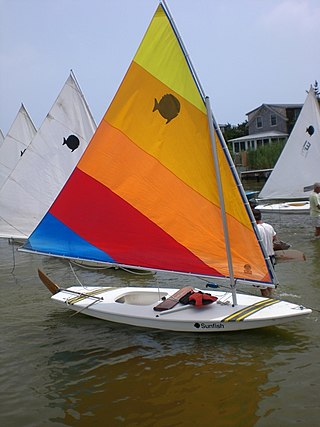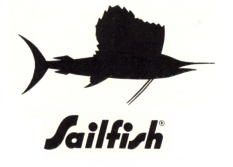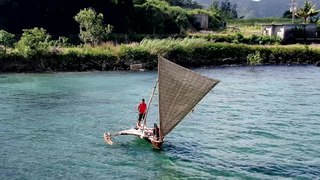
A sailboat or sailing boat is a boat propelled partly or entirely by sails and is smaller than a sailing ship. Distinctions in what constitutes a sailing boat and ship vary by region and maritime culture.

A sailing vessel's rig is its arrangement of masts, sails and rigging. Examples include a schooner rig, cutter rig, junk rig, etc. A rig may be broadly categorized as "fore-and-aft", "square", or a combination of both. Within the fore-and-aft category there is a variety of triangular and quadrilateral sail shapes. Spars or battens may be used to help shape a given kind of sail. Each rig may be described with a sail plan—formally, a drawing of a vessel, viewed from the side.

A catboat is a sailboat with a single sail on a single mast set well forward in the bow of a very beamy and (usually) shallow draft hull. Typically they are gaff rigged, though Bermuda rig is also used. Most are fitted with a centreboard, although some have a keel. The hull can be 3.7 to 12.2 metres long with a beam half as wide as the hull length at the waterline. The type is mainly found on that part of the Eastern seaboard of the USA from New Jersey to Massachusetts.

Kool is an American brand of menthol cigarette, currently owned and manufactured by ITG Brands LLC, a subsidiary of Imperial Tobacco Company. Kool cigarettes sold outside of the United States are manufactured by British American Tobacco.

The Laser is a class of single-handed, one-design sailing dinghies using a common hull design with three interchangeable rigs of different sail areas, appropriate to a given combination of wind strength and crew weight. Ian Bruce and Bruce Kirby designed the Laser in 1970 with an emphasis on simplicity and performance.

Proas are various types of multi-hull outrigger sailboats of the Austronesian peoples. The terms were used for native Austronesian ships in European records during the Colonial era indiscriminately, and thus can confusingly refer to the double-ended single-outrigger boats of Oceania, the double-outrigger boats of Island Southeast Asia, and sometimes ships with no outriggers or sails at all.

The Sunfish is a personal-size, beach-launched sailing dinghy. It features a very flat, boardlike hull carrying an Oceanic lateen sail mounted to an un-stayed mast.
The term beachcat is an informal name for one of the most common types of small recreational sailboats, minimalist 14 to 20 foot catamarans, almost always with a cloth "trampoline" stretched between the two hulls, typically made of fiberglass or more recently rotomolded plastic. The name comes from the fact that they are designed to be sailed directly off a sand beach, unlike most other small boats which are launched from a ramp. The average 8 foot width of the beachcat means it can also sit upright on the sand and is quite stable in this position, unlike a monohull of the same size. The Hobie 14 and Hobie 16 are two of the earliest boats of this type that achieved widespread popularity, and popularized the term as well as created the template for this type of boat.

The Mutineer 15 is a 15-foot (4.6 m) long fractional sloop sailboat currently manufactured by Nickels Boat Works. It has a dinghy centerboard hull, no ballast, and displaces 410 pounds. The Mutineer 15 has a 6-foot (1.8 m) beam, maximum draw of 4.08 feet (1.24 m), and has 150 square feet (14 m2) of sail area. The Mutineer 15 is commonly used for both day sailing and class racing. The Mutineer 15 can be comfortably sailed as a day sailer with a crew of four, but can also be raced with a crew of two, or even single-handed by semi-experienced to experienced sailors.

The Penguin is an American sailing dinghy that was designed by Philip Rhodes in 1933 as a one design racer for frostbite racing on the US east coast and first built in 1939.

The Phantom is a British sailing dinghy that was designed by Paul Wright and Brian Taylor as a one-design racer and first built in 1971.

Paraw are various double outrigger sail boats in the Philippines. It is a general term and thus can refer to a range of ship types, from small fishing canoes to large merchant lashed-lug plank boats with two outriggers (katig) propelled by sails

The Sailfish sailboat is a small, hollow body, board-boat style sailing dinghy. The design is a shallow draft, sit-upon hull carrying a crab claw sail mounted to an un-stayed mast. This style sailboat is sometimes referred to as a "wet boat" because, with its minimal freeboard, the sailor often gets splashed by spray as the boat moves across the water. This flat top was known in some coves as the "ironing board of the ocean."

LaserPerformance is an Anglo-American dinghy manufacturer. LaserPerformance manufactures many sailboats including: Laser, Sunfish, Bug, Laser Vago, Laser Bahia, Club FJ, Club 420, Z420, Vanguard 15, Dart 16, Funboat and Optimists.

A bracera or brazzera is a traditional Adriatic coastal cargo sailing vessel originated in Dalmatia and first recorded in the 16th-century chronicles. Along with its larger sisters - trabakuls and peligs, braceras formed the backbone of the commercial fleet on the Adriatic Sea with one masted one being the most prominent and best known. This solid and very mobile boat with wide hips and blunt bow was particularly suitable for commerce and communication between the many islands of the Adriatic as well as neighboring coasts. Already in the 19th century over 800 of them were listed in the Austro-Hungarian fleet register covering vessels of the Dalmatian and Istrian coasts. Adriatic braceras distinguish from the vessels carrying same/similar names like, for example, in the Aegean Sea. Unlike there, on the Adriatic the term refers to the entire boat, the system that consists of the hull and the rig as well, and not merely the sail.

A sail is a tensile structure, which is made from fabric or other membrane materials, that uses wind power to propel sailing craft, including sailing ships, sailboats, windsurfers, ice boats, and even sail-powered land vehicles. Sails may be made from a combination of woven materials—including canvas or polyester cloth, laminated membranes or bonded filaments, usually in a three- or four-sided shape.

Kaep is a traditional type of double-ended Proa sailboat native to Palau. Some of the essential design elements have also been adopted as a modern smaller multihull prototype variant.
The Gougeon 32 is an American trailerable catamaran that was designed by Jan Gougeon and first built in 1990.
The Phantom 14 is an American sailing dinghy that was designed by Jack Howie as a racer and first built in 1977. It is a board sailboat, similar to the Sunfish.
The Dolphin 15 Senior, sometimes referred to as just the Dolphin Senior, is an American sailing dinghy that was designed by brothers Glenn Corcoran and Murray Corcoran and first built in 1964.



















